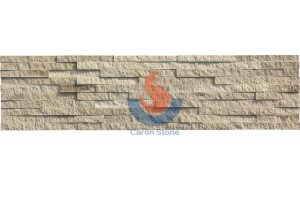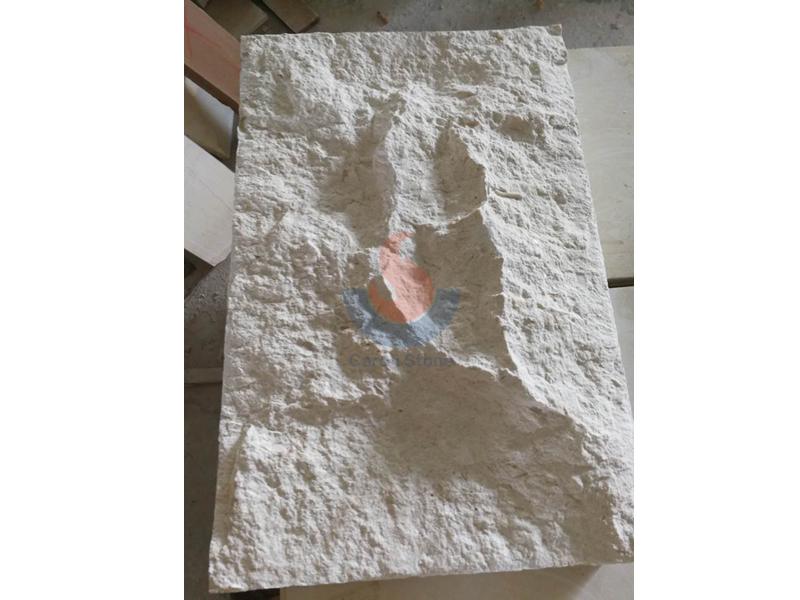Limestone, this seemingly ordinary rock, actually plays an important role in nature and human civilization. Being a sedimentary rock, limestone is not only a valuable study tool in geology but also finds application in many other disciplines including industry and building. This article will guide readers to investigate the creation process of limestone, expose its geological beauties, and present its extensive use in the field of building materials, so illustrating how limestone has evolved from a geological wonder to a major component for contemporary building.

Portuguese Beige Limestone Splitted Culture Stone
1. Geological Formation of Limestone
1.1 Geological Formation Process
Limestone is mainly composed of calcite (CaCO₃) and is a sedimentary rock. Usually, its development process is intimately connected to the sea surroundings. A thick layer of limestone is progressively developed when calcium carbonate (CaCO₃) from sediments including biological remnants, coral, and shells is liberated from them and settles on the seafloor. These sediments compact and consolidate over time to produce the limestone we know today.
1.2 Geological wonders
The formation of limestone is not only a long geological process, but also accompanied by many geological wonders. For instance, limestone caves are naturally occurring scenes created by limestone under long-term acidity of water erosion. Groundwater dissolves some minerals and creates unusual underground scenes including stalactites and stalagmites when it flows through the limestone layer. These geological marvels offer extensive information for geological study in addition to their inherent beauty of limestone.
2. Limestone architectural application
2.1 Evolution of building materials
Limestone has a long history of use as a building material. Marble was extensively employed in ancient civilizations including Egypt, Greece, and Rome to create great monuments and sculptures. For instance, still standing today, the Parthenon of ancient Greece and the Egyptian pyramids were constructed from limestone. Limestone is preferred for its natural color and texture that would fit the surroundings in addition to its great carving ease.
2.2 Application in modern architecture
Still a major architectural component in modern architecture is limestone. It is extensively applied in flooring, interior décor, and building outside walls. Good durability and beauty define limestone, which is appropriate for several architectural designs. Modern designers and builders sometimes exploit limestone’s natural texture and color variations to produce distinctive architectural impacts. Furthermore giving a range of options for modern constructions, limestone is also utilized to create building materials including stone bricks and stone slabs.
2.3 Eco-friendly Choice
Another major advantage of limestone as a building material is its eco-friendly nature. The ecology is fairly unaffected by limestone mining and processing. Its makeup consists mostly of naturally occurring minerals and excludes any dangerous elements. Furthermore utilized in cement manufacture is limestone. In this method, the limestone not only raises cement’s strength but also lowers carbon emissions, therefore benefiting the environment.
3. Future Limestone Development
3.1 Application of New Technologies
The fields of limestone application are likewise growing as science and technology advance. For instance, contemporary technologies have made the use of limestone in building more exact and effective. Through advanced processing technology, limestone can be made into various shapes and specifications to meet the needs of different architectural designs. Furthermore, new technology have made limestone more extensively employed in green buildings—that is, as ecologically friendly materials and energy sources.
3.2 Direction of sustainable development
The use of limestone in the field of construction materials will give sustainable development more priority in the future. The mining and processing process of limestone needs to be further optimized to reduce the impact on the environment. At the same time, promoting the recycling and resource regeneration of limestone can enable this traditional material to play a greater role in modern buildings. limestone will remain in a major role in the building sector and help sustainable development by means of innovative ideas combined with environmental protection technologies.

Natural limestone splited finished wall tile wall cladding panel stacked stone
From geological marvels to building materials, limestone’s path reveals the beauties of nature and the wisdom of human society. Its formation process offers us numerous natural resources in addition to reflecting the earthly geological activity. With its environmental protection, durability, and beauty, limestone has become rather popular as a building material. In the future, with the advancement of technology and the promotion of the concept of sustainable development, limestone will continue to play its important role and bring more innovations and possibilities to the construction industry. Apart from honoring nature, the amazing voyage of limestone pays tribute to architectural art by means of constant discovery and creativity.





